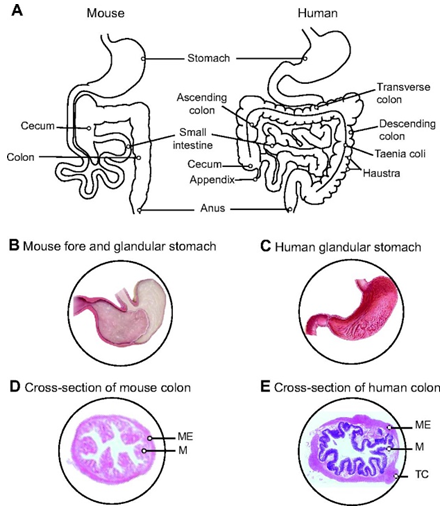Researchers have joined the consensus that the microbiota that colonizes the human gastrointestinal tract plays a significant role in human physiology, owing to its association with health conditions and a wide range of diseases. Various approaches have been applied to elucidate the underlying mechanisms of how the microbiota interacts with its host, and the methodologies for modeling human microbiota in animal systems have developed into a valid in vivo study protocol.
Animal models allow perturbations in the gut microbiota to be studied in a controlled experimental setup, and thus help in assessing causality of the complex host-microbiota interactions and in developing mechanistic hypotheses. Model organism approaches have facilitated numerous studies into different areas, including disease-associated alterations in gut microbiota composition, and more recently, the gut-brain axis that indicates the bidirectional interactions of the microbiota on host brain function.
Figure 1. Gross anatomy of the human and the mouse gastrointestinal tract (Nguyen 2015)
CD Genomics, a preeminent corporation that specializes in multi-omics and equipped with state-of-the-art techniques and bioinformatics platforms, provides various solutions for your gut microbiota research. As using animal models in gut microbiota studies undoubtedly brings more insights into this field, we provide both mammalian model organisms and non-mammalian model organisms as valid approaches to simulate the human gut environment and study the dynamic and complex relationship between the gut microbiota and its host.
| Model Animal | Technology Demand & Cost | Compatibility with human-derived microbes |
| house mouse (Mus musculus) | Technically demanding and costly to produce and maintain | Yes |
| rat (Rattus norvegicus) | ||
| zebrafish (Danio rerio) | Technically straightforward until 6-8-days-old | Aerotolerant taxa, not obligate anaerobes |
| fruit fly (Drosophila melanogaster) | Technically straightforward and cost-effective | |
| nematode worm (Caenorhabditis elegans) |
We offer customization and services for a variety of model organisms to meet different research purposes – such as mouse as a model organism, as well as some non-murine models such as zebrafish, and fruit fly, these non-mammalian models have short developmental time and small-scale genome for analysis, and they are more compatible with some of the state-of-the-art genetic techniques including RNA interference (RNAi) for fruit fly and morpholino injection technique for zebrafish.
We dedicate to providing the highest level of service in gut microbiota research. We will offer the most suitable strategies according to your research purpose – we can assist you in designing studies and interpreting results to identify mechanistic links between microbiota and the host, in order to address practical issues like finding novel disease treatment methods by reviving human disease model in animal systems. If you want to find out more about our model organism services, please feel free to contact us. We will arrange experienced scientists to provide you with professional advice and optional services according to your project.
Reference
1. Nguyen TLA; et al. How informative is the mouse for human gut microbiota research? Disease Models & Mechanisms. 2015, 8(1): 1.
*For Research Use Only. Not for use in diagnostic procedures.
- CRISPR/Cas9 Gene Editing Service
- RNAi Service
- Antibiotic Resistance Testing Services
- Flow cytometry Analysis Service
- Gut Microbiota Fluorescent in situ Hybridization (FISH) Service
- Gut Bioreactor Service
- Microfluidics Services for Gut Microbiome Research
- Western Blot Service for Gut Microbiome Research


